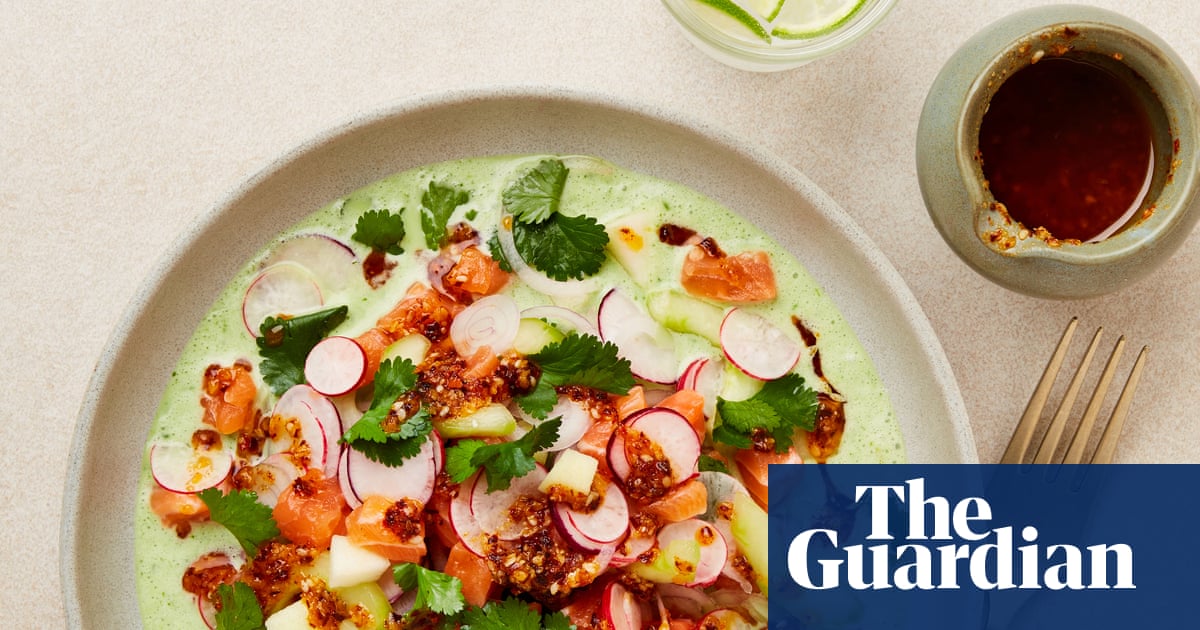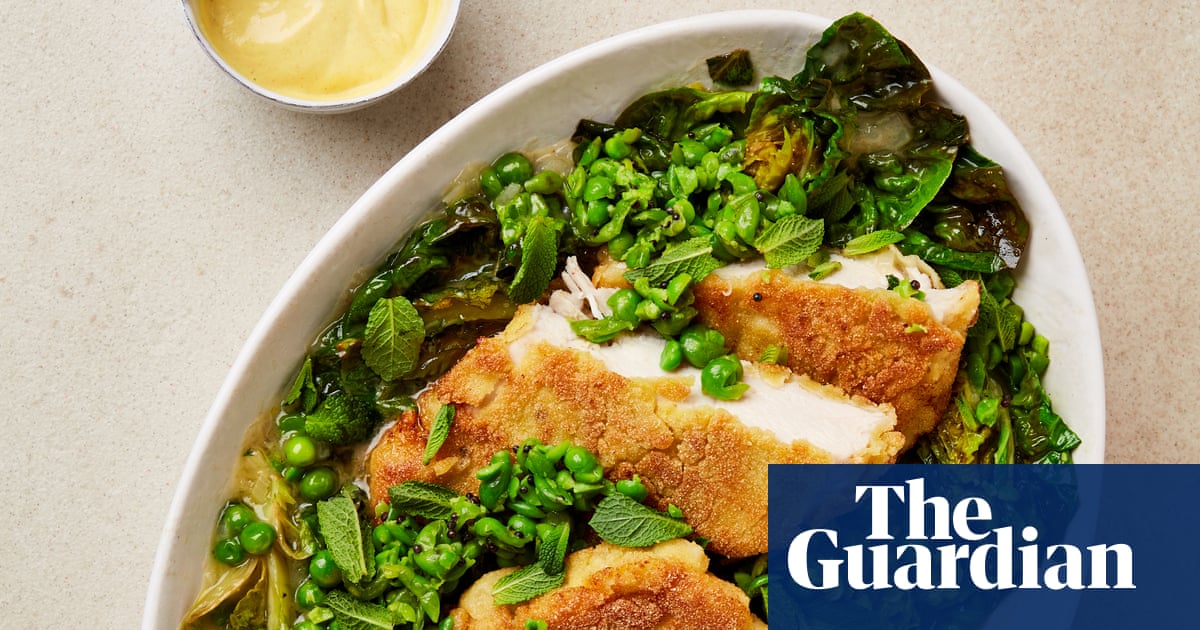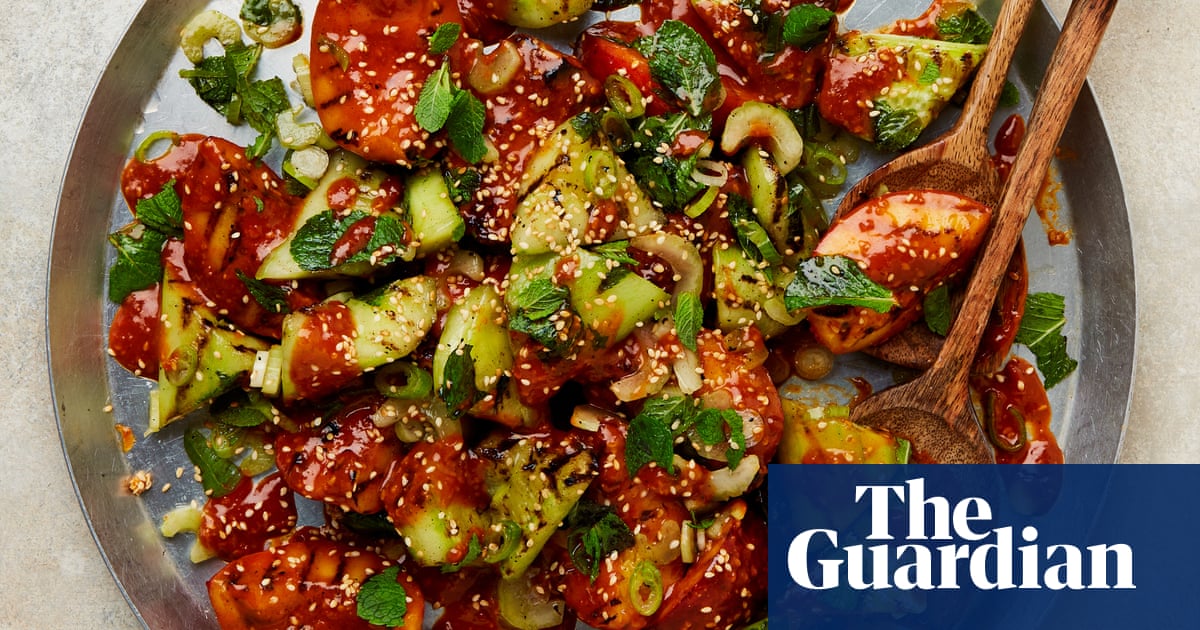
Looking back at my previous coconut recipes for this column, I see that they are all BC. That has nothing to do with Bounty bars, or even coconuts; BC stands for “before Chaya”. You see, before Chaya Maya arrived in the test kitchen, the starting point for recipes with coconut was usually a hankering simply to be elsewhere, somewhere warmer and farther afield – that ultimate coconut-cliche, basically, namely somewhere tropical. Now that we have Chaya in the team, however, I don’t need to dream of being elsewhere, because so many of her recipes already shine with her sunny, Mauritian roots. The transportive power of food: coconut recipes, tropical north-London style.
Chilled coconut broth with salmon crudo and sesame-aleppo oil (pictured top)
This is a stunning starter for a dinner party. Make all the components a day ahead and store them separately in the fridge. Don’t add the lime juice until just before serving, though, so everything keeps its colour. I’ve used light coconut milk here, because full-fat would be too intense and overwhelm the delicate balance of the dish. The fish is served raw, so buy the freshest you can get.
Prep 20 min
Chill 30 min+
Cook 15 min
Serves 6
3 salmon (or trout) fillets (360g), skinned
160g radishes (about 9), cut into thin rounds
1 banana shallot (40g), peeled, thinly sliced, soaked in cold water for 20 minutes, then drained
For the coconut dressing
½ cucumber (150g)
1 large granny smith apple (160g)
1 x 400ml tin light coconut milk – avoid brands that use stabilisers and emulsifiers
1-2 jalapeños, stems removed and discarded; do the same with the pith and seeds, if you prefer less heat
½ tsp fish sauce
30g coriander
3 limes – zest of 1 finely grated, to get 1 tsp, 2 juiced, to get 2 tbsp, and 1 cut into wedges
Fine sea salt and black pepper
For the oil
3 tsp aleppo chilli flakes
2 tsp sesame seeds
60ml olive oil
First, make the dressing. Peel the cucumber and apple and put the peelings in a blender. Cut the cucumber in half lengthways, scoop out the seeds and put them in the blender, too. Put the coconut milk, jalapeño, fish sauce, two-thirds of the coriander, the lime zest, a quarter-teaspoon of salt and a good grind of pepper in the blender, then blitz for 30-45 seconds, until completely smooth. Chill for at least 30 minutes (and up to a day).
Sprinkle each fish fillet all over with a quarter-teaspoon of salt, then chill for 20 minutes. Wash off the salt, pat dry with kitchen towel, then cut the flesh into 1cm cubes.
Put the aleppo chilli, sesame seeds and an eighth of a teaspoon of salt in a mortar or the small bowl of a food processor. Coarsely grind, or pulse, then add the oil and grind (or pulse) a few more times, to combine.
To assemble, stir the lime juice into the dressing, then divide the dressing between six shallow bowls. Cut the apple into small cubes and cut the cucumber on a diagonal into ½cm-thick slices, put these in a large bowl with the salmon, radishes, shallot, remaining coriander leaves and a quarter-teaspoon of salt, and toss gently to combine. Scatter the fish mixture evenly over the dressing in the bowls, then drizzle on the aleppo oil and serve with the lime wedges for squeezing over.
The Guardian aims to publish recipes for sustainable fish. Check ratings in your region: UK; Australia; US.
Chard and green bean poriyal
Poriyal is a popular south Indian and Sri Lankan dish of stir-fried vegetables with coconut. It is fresh, vibrant and very quick to cook. Traditionally made with fresh coconut, I’ve used desiccated on the assumption that there’s at least one half-used bag in your store cupboard that needs using up. That said, use fresh instead, if you prefer – quantity-wise, the substitution is like for like. Toasted urad dal adds a wonderfully nutty flavour to the dish, as well as a bit of crunch, but if you don’t have any to hand, use flaked almonds or roughly chopped cashews instead.
Prep 10 min
Cook 20 min
Serves 4-6, as a side
200g fine green beans, trimmed and cut into three pieces
3 tbsp olive oil
Fine sea salt
2 tsp black mustard seeds, steeped in 2 tbsp boiling water for 5 minutes
200g rainbow chard, leaves and stalks separated, stalks cut into 5cm pieces, leaves roughly torn
1 small red onion, peeled and finely chopped (160g)
4 garlic cloves, peeled and finely sliced
1 red chilli, deseeded and finely sliced
2 tbsp urad dal (optional)
45g desiccated coconut, or grated fresh coconut
10 fresh curry leaves
1 lime, halved
Put a large frying pan on a high heat. In a medium bowl, toss the beans with a tablespoon of the oil and a half-teaspoon of salt, then drop into the scorching hot pan and cook, stirring regularly, for six minutes, until the beans are cooked through and well charred. Tip back into the bowl and turn down the heat under the pan to medium-high.
Strain the water from the mustard seeds into the bean bowl, then tip the wet seeds into the hot pan. Add the remaining two tablespoons of oil, the chard stalks, onion, garlic, chilli, dal (if using), coconut, curry leaves and half a teaspoon of salt, then cook, stirring constantly, for three minutes, until the onions start to soften and the spices smell fragrant. Add the chard leaves, cook for a minute, just until they start to wilt, then return the beans to the pan and cook, stirring, for a further 30 seconds, until all the vegetables are well coated in the coconut mixture and are good and hot. Transfer to a platter, squeeze the lime halves over the top and serve.
Coconut, caramel and cardamom cake
The inspiration for this cake comes from Scandinavian drømmekage, or “dream cake”. The coconut caramel is sometimes poured into the base, which gives it a fudgy, Bounty-like texture, but I’ve put it on top, so it looks a bit like a dreamy, scraggly macaroon. It will keep covered at room temperature for three days.
Prep 25 min
Cook 1 hr 10 min
Serves 8
For the coconut caramel
120g caster sugar
250ml coconut milk
¼ tsp flaky sea salt
300g fresh coconut, coarsely grated, or frozen grated coconut
30g unsalted butter, plus extra for greasing
For the cake batter
3 eggs
220g caster sugar
10 cardamom pods, bashed open in a mortar, pods discarded and seeds ground, to get ¾ tsp
½ tsp flaky sea salt
220g plain flour
2 tsp baking powder
80g unsalted butter, melted
150ml coconut milk
To serve
Greek yoghurt
To make the caramel, put the sugar in a medium saucepan on a medium-high heat and cook for five minutes, gently swirling the sugar around as the edges start to melt and resisting the urge to stir. Once the sugar is melted and uniformly amber, carefully pour in the coconut milk and salt, and stir in – take care to avoid any splattering. Stir in the grated coconut, cook for two to three minutes more, until the coconut releases its liquid and the caramel thickens, then stir in the butter, take off the heat and leave to cool.
Heat the oven to 190C (170C fan)/375F/gas 5. Line a 23cm round springform cake tin with baking paper and lightly grease the sides.
To make the cake batter, put the eggs, sugar, cardamom and salt in the bowl of a stand mixer fitted with a whisk attachment, then beat for about four minutes, until fluffy and doubled in size. Sieve the flour and baking powder into a bowl, then fold into the egg mixture a third at a time. Mix the melted butter and coconut milk, then stir into the batter a third at a time, until well combined.
Pour the batter into the lined tin and bake for 40 minutes, until golden on top. Take the tin out of the oven, spoon the caramel coconut mixture all over the top, then bake for another 15-20 minutes, until the top is golden and slightly crisp. Remove, leave to cool for five minutes, then run a sharp knife all around the edge to help release the cake from the tin. Unclip the tin and put the cake, still on its paper and cake tin base, on a rack and leave to cool.
Remove the paper and cake tin base, transfer the cake to a platter and serve with a good spoonful of yoghurt.












